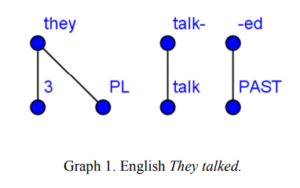Introduction
There are many languages out there in the world. Each language has their own set of grammar that sets them apart from one another. Often when we learn a new language , depending on what we learn the ease of learning is easier or harder. Often times English is denoted as a difficult language due to its many exceptions in its grammar. However, most opinions are subjective so it leads to a lot of vague notions. This article tries to measure the linguistic complexity in a more quantifiable measurement.
Analysis
One way to analyze a language is morphologically. That is studying the internal structure of the words itself. Words can be split up into small meaningful units called morphemes. The morphemes are not a word but when combined with other morphemes, it creates a meaning to the word. A simple example is in dogs, the -s in dogs is a morpheme that has the meaning of converting a singular noun into plural. When mapped into a graph there are two tiers, the form tier (eg. -s) and the meaning tier (eg. plural). The vertex represent either a form or meaning and the edge represents the form’s connection to the meaning. The form can have multiple meanings and multiple forms can have the same meaning. Below is an example of an English sentence.

There are multiple ways that you can calculate complexity. Whether it be by the number of vertices in the meaning tier (conceptual complexity) , the number of vertices in the form tier (formal complexity) or the average vertex degree in the graph (form-meaning correspondence complexity). There are limitations to these methods as not all languages can be separated into morphemes as clear as it is in English and there may not be equivalent sentences to compare against.
Conclusion
Overall, it gives some insight into how we can quantifiably calculate complexity of a language’s grammar using graph theory. While it is not an all powerful way to measure overall complexity , it is a helpful tool into comparing between similar like languages.
Reference
Piperski, Alexander. “An application of graph theory to linguistic complexity” Yearbook of the Poznan Linguistic Meeting, vol.1, no.1, 2015, pp.89-102. https://doi.org/10.1515/yplm-2015-0005